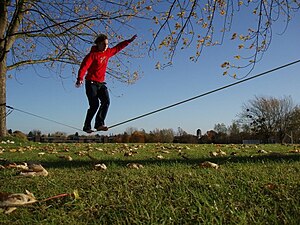Slacklining
Slacklines are tensioned significantly less than tightropes or tightwires in order to create a dynamic line which will stretch and bounce like a long and narrow trampoline.Another type of urbanlining is streetlining, which combines street workout power moves with the slackline's dynamic, shaky, bouncy feeling.When rigging highlines, experienced slackers take measures to ensure that solid, redundant and equalized anchors are used to secure the line into position.To balance on a 1-inch (2.5 cm) piece of webbing lightly tensioned between two trees is not easy[citation needed], and doing yoga poses on it is even more challenging.While rope walking has been around in one manner or another for thousands of years, the origins of modern-day slacklining are generally attributed to a rock climber named Adam Grosowsky from southern Illinois in 1976 when he was sixteen.[16][17] In 1995, Darrin Carter performed unprotected crossings of the Lost Arrow Spire in Yosemite and The Fins, in Tucson, Arizona, on Mt.Friedi Kühne, Lukas Irmler, Quirin Herterich and Ruben Langer (all from Germany) crossed a 2.1-kilometre (1.3 mi) slackline suspended more than 500 metres (1,600 ft) high between the Lapporten mountains near Abisko, Sweden.[21] At a length of 110m and a height of 200m, the longest free solo highline was walked at the Verdon Gorge in Southern France by German Slackliner Friedi Kühne.Rafael Zugno Bridi currently holds the world record who walked a slackline between two hot air balloons.[25] In 2015, Stephan Siegrist performed a slackline walk in the summit area of Mount Kilimanjaro at an altitude exceeding 5,500 meters above sea level.[26] The current world record for the highest urban highline is held by Friedi Kühne, Mia Noblet, Gennady Skripko, Vladimir Murzaev, Maksim Kagin, Alexander Gribanov, and Nathan Paulin.




balancingwebbingtensionedanchorstightrope walkingtrampolineTyrolean traverseswami beltDean PotterAndy LewisvinyasaThe Wall Street JournalYoga JournalColby CollegeWaterville, MaineIllinoisGiovanna PetrucciIpanemaNew York TimeshighwirePasadena, CaliforniaFriedi KühneLapportenAbiskoSwedenKjeragRogalandNorwayBern, SwitzerlandLausanne, SwitzerlandJultagiBBC NewsClimbing.comYouTubeThe New York TimesCircus skillsAcrobaticsbalancecontortionAcrobalanceAdagioAerial hoopAerial silkAerial strapsBalance boardChair acrobaticsChinese poleCloud swingCorde lisseCradleCyr wheelHair hangHand to handHuman pyramidRisleyRolling globeRoman laddersRussian barRussian swingSlackwireSpanish webTightropeTrapezeFlyingStaticTrick ridingJugglingobjectmanipulationBullwhipCigar box manipulationContact jugglingDiaboloHat manipulationTwirlingFire performanceFire breathingFire eatingFirewalkingToss jugglingVaultingEquestrian vaultingHuman cannonballTeeterboardAnimal trainerLion tamingCircus clownGlobe of deathHuman firecrackerPuppeteerRingmasterStrongmanTarget girlWheel of DeathCircus schoolRoustaboutShowmanSideshowFlea circusExtreme and adventure sportsBoardsportsBellyboardingBodyboardingDirtsurfingKite landboardingKiteboardingLongboardingMountainboardingRiverboardingSandboardingSkateboardingSkimboardingSkysurfingSnowboardingSnowskatingStreet lugingSurfingRiver surfingWakeboardingWindsurfingMotorsportsDriftingMotocrossRallycrossRallyingRally raidSnocross